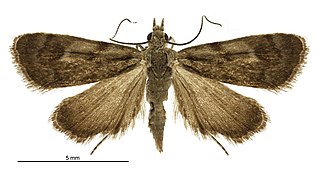
Epinotia ramella is a moth of the family Tortricidae. It is found in Europe, China, Japan, Russia and Kazakhstan.

Asterivora exocha is a species of moth in the family Choreutidae. It was first described by Edward Meyrick in 1907 and is endemic to New Zealand. This species has only been observed in the Humboldt Ranges of Otago and inhabits subalpine native bush at elevations of around 3600 ft. Adults of this species are on the wing in December and January and have been observed flying at dusk.

Glaucocharis stella is a species of moth in the family Crambidae. It is endemic to New Zealand.

Eudonia zophochlaena is a moth in the family Crambidae. It was described by Edward Meyrick in 1923. It is endemic to New Zealand. It has been hypothesised that this species is a North Island endemic. The adults of this species are on the wing from December until February. The larvae of this species are leaf miners of the leather-leaf fern Pyrrosia eleagnifolia.

Metaeuchromius glacialis is a moth in the family Crambidae. It was described by Wei-Chun Li in 2015. It is only known from Galongla Mountain, in Mêdog County in Tibet, China.
Mnesictena pantheropa is a moth in the family Crambidae. It was described by Edward Meyrick in 1884. It is endemic to New Zealand, where it has been recorded from the Chatham Islands.
Aroga elaboratella is a moth of the family Gelechiidae. It is found in North America, where it has been recorded from California and Baja California.
Telphusa smaragdopis is a moth of the family Gelechiidae. It is found in Costa Rica.
Telphusa callitechna is a moth of the family Gelechiidae. It is found in Guyana and French Guiana.
Telphusa delatrix is a moth of the family Gelechiidae. It is found in Peru.
Telphusa iriditis is a moth of the family Gelechiidae. It is found in Namibia.
Telphusa objecta is a moth of the family Gelechiidae described by Edward Meyrick in 1921. It is found in Zimbabwe.
Telphusa retecta is a moth of the family Gelechiidae first described by Edward Meyrick in 1921. It is found in South Africa.
Telphusa syndelta is a moth of the family Gelechiidae first described by Edward Meyrick in 1921. It is found in Zimbabwe.
Telphusa prasinoleuca is a moth of the family Gelechiidae. It is found in Indonesia (Java).
Antaeotricha balanocentra is a species of moth of the family Depressariidae. It is found in Guyana.
Stenoma platyterma is a moth of the family Depressariidae. It is found in Guyana.
Chlamydastis ophiopa is a moth of the family Depressariidae. It is found in French Guiana.

Scythris niphozela is a species of moth in the family Scythrididae. It is endemic to New Zealand. It is regarded as endemic to the Kaitorete Spit area although it had been recorded in the Manorburn Ecological District. This species inhabits the foredune area of Kaitorete Spit. The larvae feed on Carmichaelia appressa. Adults day fly from October to December. These moths are not attracted to light. The species is classified as "At Risk, Naturally Uncommon" by the New Zealand Department of Conservation.

Proteodes melographa is a species of moth in the family Depressariidae. It is endemic to New Zealand and has been observed at Mount Arthur and in the Nelson District. It inhabits forest in the alpine zone. The larvae of this species feeds on native beech trees.







